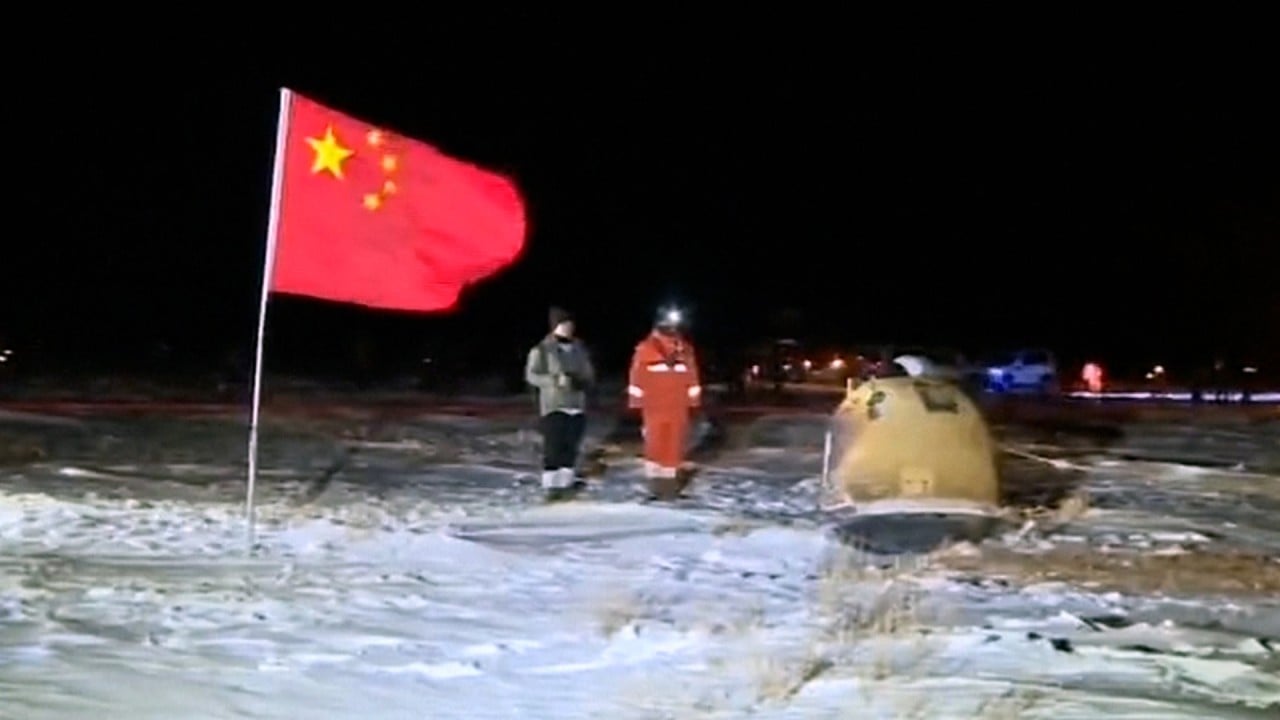
01:28
China’s Chang’e 5 lunar mission returns to Earth with moon samples

The water content of soil on one part of the moon appears to be much lower than previously thought, according to Chinese analysis of data from the lunar surface.
And a significant part of the water detected in returned samples during lab analysis appears to have come from the interior of the moon, the researchers said in a paper published in the international journal Nature Communications on Tuesday.
The team looked at samples and readings collected from the landing site of the Chang’e 5 unmanned lunar exploration mission in 2020, the first from China to land on the moon and bring samples back.
Equipment on the Chang’e 5 lander scanned the surface and measured the mean water content to around 30 parts per million (ppm), or 30 grams of water per tonne of soil.
The result was remarkably low compared to previous analysis, including research published in January by another Chinese team that concluded the maximum water concentration in surface soil at 120ppm.
Liu Jianjun, from the National Astronomical Observatories in Beijing, said the Chang’e 5 equipment measured the presence of hydroxyl, a close chemical relative of water that is also an indicator of water.
“In processing and interpreting the data, we considered various factors which may affect our measurements, such as the moon surface temperature and real-time influences from the sun, and we tried to make our data as ‘clean’ as possible,” Liu, the paper’s lead author, said.
He said the results were consistent with the water distribution level detected by ground-based telescopes at similar latitudes on the moon.
Liu and his colleagues also analysed samples brought back by Chang’e 5 to try to understand where the hydroxyl came from.
The samples pointed to multiple sources.
“We compared Chang’e 5 samples with Apollo 11 samples, and estimated that the concentration of water formed as a result of solar wind implantation was about 18ppm,” Liu said.
In the solar wind implantation process, hydrogen ions from the sun constantly bombard the moon’s surface and combine with oxygen in lunar minerals to form hydroxyl and even water.
The rest was attributed to hydroxyl-bearing apatite, a mineral on the moon that crystallised as lunar magma cooled billions of years ago, the paper said.
“That would be another important source of water, trapped in the mineral and brought to the lunar surface by volcanic eruptions,” Liu said.
The moon had been considered totally dry until the presence of water was confirmed by India’s Chandrayaan 1 mission about a decade ago. Thanks to technological advances, scientists can now detect tiny amounts of water in Apollo, Luna, and Chang’e 5 samples brought back by US, Soviet and Chinese missions.
But the source of the moon’s water remains an open question, with possibilities including solar wind implantation, the moon’s interior, or water-bearing comets striking the lunar surface.
Finding out where the water is and where it comes from is important not only to understanding the moon’s past, but also to sustaining a lunar base.
While the Chang’e 5 equipment on the moon has stopped working, damaged as the return capsule lifted off from the lander, there is still plenty of work to do in the lab on further the subject, according to Liu.
He said the team planned to look for other minerals that might host water on the lunar surface, scouring data and samples for traces.